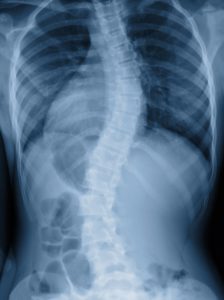Don’t Get Bent Out of Shape from Scoliosis
The human spine has natural, healthy curvatures built into it such as the arch in the low back or the slight rounding of the upper back. These curvatures are exclusive to what is called the sagittal plane, which means they either bend only forwards or backwards. Sometimes individuals can have “extra” curvatures in their back which deviates from this normal alignment. Those “extra” curvatures are what is considered scoliosis. Scoliosis curvatures are most notably characterized by side to side bending of the spine in addition to the natural the forward and backwards bending mentioned earlier.
 These abnormal side to side bends in the spine can affect upright posture, an individual’s ability to participate in the activities they love most, or just be downright painful! Scoliosis cannot be completely cured unfortunately, but the symptoms and severity can certainly be improved and managed. Physical therapy treatment can help with this by focusing on strengthening the supporting back and trunk muscles, improving posture, and restoring as much movement in the spine as possible. Strong core and hip muscles can help support the spine and decrease the amount of force that is put onto the joints in the back. A spine with scoliosis can get stiff when moving in certain directions due to the already abnormal posture, so a physical therapist might also prescribe specific stretches to help improve the mobility in certain directions.
These abnormal side to side bends in the spine can affect upright posture, an individual’s ability to participate in the activities they love most, or just be downright painful! Scoliosis cannot be completely cured unfortunately, but the symptoms and severity can certainly be improved and managed. Physical therapy treatment can help with this by focusing on strengthening the supporting back and trunk muscles, improving posture, and restoring as much movement in the spine as possible. Strong core and hip muscles can help support the spine and decrease the amount of force that is put onto the joints in the back. A spine with scoliosis can get stiff when moving in certain directions due to the already abnormal posture, so a physical therapist might also prescribe specific stretches to help improve the mobility in certain directions.
A simple screen, called the forward bend test, is something anyone can try and home to look for potential signs of scoliosis. An individual is simply asked to bend down and try to touch their toes while their back is assessed. As seen in the picture below, a normal test will result in an even rounding on each side of the back, but someone with scoliosis might have one side higher than the other! This is a simple way to look for signs of scoliosis in order to facilitate getting someone the care they need, but it is always best to be examined by a medical professional before self-diagnosing.
Even if you don’t remember a specific injury or event that may have caused back pain, it is important to still be screened for scoliosis if you never have before. An injury is not required for an individual to have scoliosis. Despite the relative commonality of the diagnosis, up to 80% of all cases are unknown why they occur. Don’t make the mistake of thinking it is too late to get help with scoliosis; the sooner a medical professional can help with treatment for scoliosis, the better the results.
Call AzOPT today and schedule an appointment at any one of our clinics to get the help and treatment you need to get back on track to a healthier and pain-free life!








